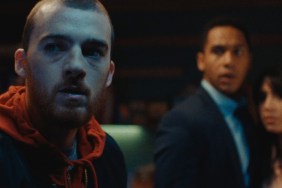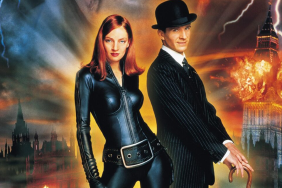Cast:
Tom Hanks as Dr. Henry Goose / Isaac Sachs / Dermot ‘Duster’ Hoggins / Valleysman Zachry
Halle Berry as Luisa Rey / Meronym / Jocasta Ayrs
Jim Broadbent as Vyvyan Ayrs / Timothy Cavendish
Doona Bae as Sonmi-451
Jim Sturgess as Adam Ewing / Hae-Joo Im
Ben Whishaw as Robert Frobisher
Hugo Weaving as Bill Smoke / Nurse Noakes / Old Georgie
Susan Sarandon as Ursula
Hugh Grant as Alberto Grimaldi / Cannibal
Keith David as Joe Napier – Kupaka & Ankor Apis
James D’Arcy as Rufus Sixsmith
Xun Zhou as Yoona-939 / Rose
Zhu Zhu
Götz Otto as Withers
David Gyasi as Autua
Alistair Petrie as Felix Finch
Louis Dempsey as Jarvis Hoggan
Brody Nicholas Lee as Javier
Mya-Lecia Naylor as Miro
Valerie Lillibeth as Muse of the Lemon Prize winner
Raevan Lee Hanan as Catkin
Daniele Rizzo as Co-Worker in San Francisco
Robin Morrissey as Young Cavendish
Directed by Tom Tykwer, Andy and Lana Wachowski
Story:
Six interlocking stories are strung together into a single narrative:
In 1849, lawyer Adam Ewing (Jim Sturgess) lays in the hold of a ship suffering from a debilitating illness, while being cared for by Dr. Henry Goose (Tom Hanks) who has his own motives, while in 1936, Robert Frobisher (Ben Whishaw) gets a job as the assistant to a crotchety composer (Jim Broadbent). In 1973 San Francisco, reporter Luisa Rey (Halle Berry) is given a tip that the Swanneke nuclear power plant may not be as stable as reported, information that puts her life in danger, while in present day, publisher Tim Cavendish (Broadbent) goes on the lamb after angering the criminal brothers of one of his authors but ends up being committed to a retirement home. Decades in the future, fabricants are used to conduct menial jobs and restaurant worker Somni-451 (Doona Bae) learns there’s more to life than serving consumers when she’s saved by a young rebel (Sturgess), and in the far future, a primitive tribesman named Zachry (Hanks) takes in a house guest named Meronym (Berry), who comes from a far more evolved society.
Analysis:
The return of “The Matrix” creators Andy and Lana Wachowski and their teaming with “Run Lola Run” director Tom Tykwer on an adaptation of David Mitchell’s 2003 novel “Cloud Atlas” was already considered one of the boldest decisions of the year. Mitchell’s novel was considered by many as unadaptable since it consists of six stories that act almost like nesting dolls, beginning with the story of Adam Ewing, then proceeding chronologically through the other five until the far future story of Valleysman Zachry, then returning through each story until it wraps up once again with Ewing. It’s a format that’s somewhat frustrating if you’re not particularly enjoying any one of the six stories.
After a quick montage offering quick bursts of each of the six stories, we’re properly introduced to the six protagonists with roughly ten minutes of their story appearing in the same order as the novel. After that, Tykwer and the Wachowskis wisely throw away the printed format and progress with a far more intriguing structure that bounces between segments while finding clever ways of cutting between them. When publisher Tim Cavendish gets his hands on a manuscript for a mystery novel about Luisa Rey, it’s the perfect opportunity to cut back to her story and sometimes the edits are done between characters played by the same actor.
Not surprisingly, the segments of Mitchell’s novel that read the best also work best on film, maybe because they’re not written in Olde English or some affected futuristic dialogue. It also probably won’t be any sort of shocker that the creators of “The Matrix” would fit so comfortably into the science fiction world-building surrounding an expendable “fabricant” named Somni. While that is also the segment that diverges furthest from specific plot moments in the novel, it’s also filled with the type of action and special FX fans of the Wachowskis will expect. On the other hand, Adam Ewing’s sea journal has the least to offer in terms of a standalone story while the three middle stories, set between 1936 and present day and all shot by Tykwer, translate the best, the comic misadventures of Jim Broadbent’s Timothy Cavendish offering a lot of fun and Luisa Rey’s attempts at uncovering a conspiracy adding tension and action.
Some stories progress better than others and they’re sorely missed when the film shifts its focus to weaker ones, although sometimes it’s merely to show a single scene before cutting back. At first, there may not seem to be much rhyme or reason to the order in which the stories are assembled, but the editing choices greatly enhance the deeper themes of the novel by shining more light on the parallels and connections between characters in vastly divergent stories. This is also done by having narrative passages from one story read as voice-over over montages of others. Adam Ewing’s kinship with a slave in the past contrasts with the relationship in the future between the primitive white-skinned Zachry and the more evolved Meronym in the far future, which isn’t nearly obvious in Mitchell’s novel. The strange way they speak tends to make their segment the most problematic one since the viewer has a chance to adjust, but it’s beautifully shot and wisely it’s used as the framing device rather than bookending it with the weaker Ewing story.
Possibly the most fun that can be found in the film is trying to spot the dozen primary actors as they appear in different incarnations, portraying the hero in one story and the villain in another. The acting itself is fine but the only two standouts are Broadbent as the aforementioned Cavendish, while appearing as the composer and ship’s captain in earlier stories, while Hugo Weaving acts as the conflict or antagonist in all six stories, adding more humor to Cavendish’s story by appearing in drag. By comparison, Hanks tends to stick out like a sore thumb, because he’s wearing such extensive make-up and hairpieces and talking in clunky accents, that it ends to be obtrusive. Then again, this is done deliberately for humor value such as having Hanks play Cavendish in the film version of his adventures, watched by Sonmi 122 years in the future.
By effortlessly mixing so many styles and genres into one movie, “Cloud Atlas” becomes the ultimate movie for ADD sufferers. Those requiring drama or romance will find that in abundance while those just wanting tension and straight-up action should be content by the number of peaks one can put in a film where each story climaxes at a different moment.
The score, composed by Tykwer, Johnny Klimek and Reinhold Heil, is a gorgeous piece of work, easily one of the finest scores we’ve heard this year, and it does wonders at helping to pull the six stories into a cohesive whole. Then again, having so many individual stories and insuring that each of them gets their due does make for a movie that feels long at times.
The Bottom Line:
Literally six films in one, “Cloud Atlas” is as much a curiosity as it is a boldly brilliant adaptation that captures the best moments of Mitchell’s novel while improving upon the structure and enhancing the main themes. It’s a beautifully-realized puzzle that gives the viewer so much to observe and absorb and so many different ways of assembling the pieces, it’s impossible not to be pulled in by it.










